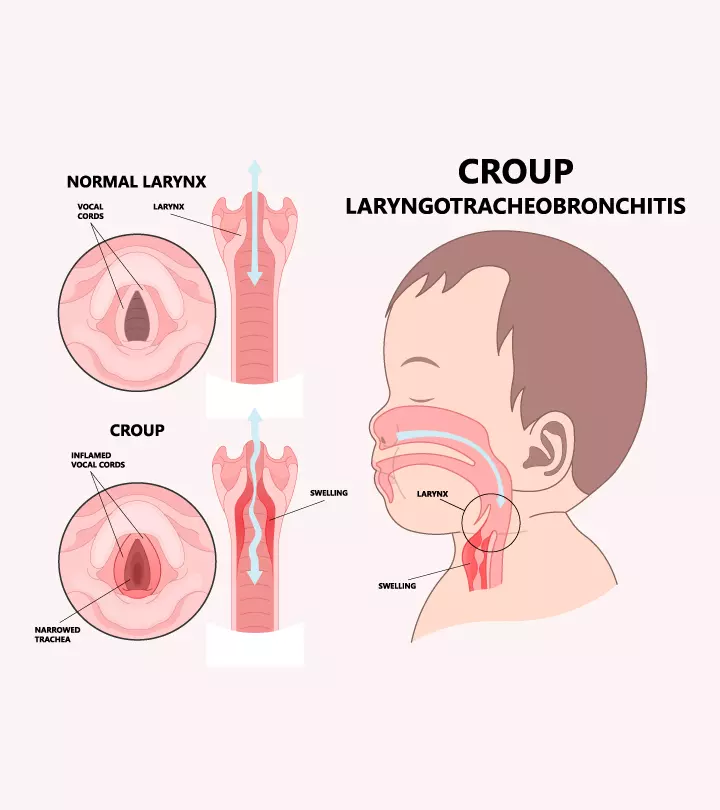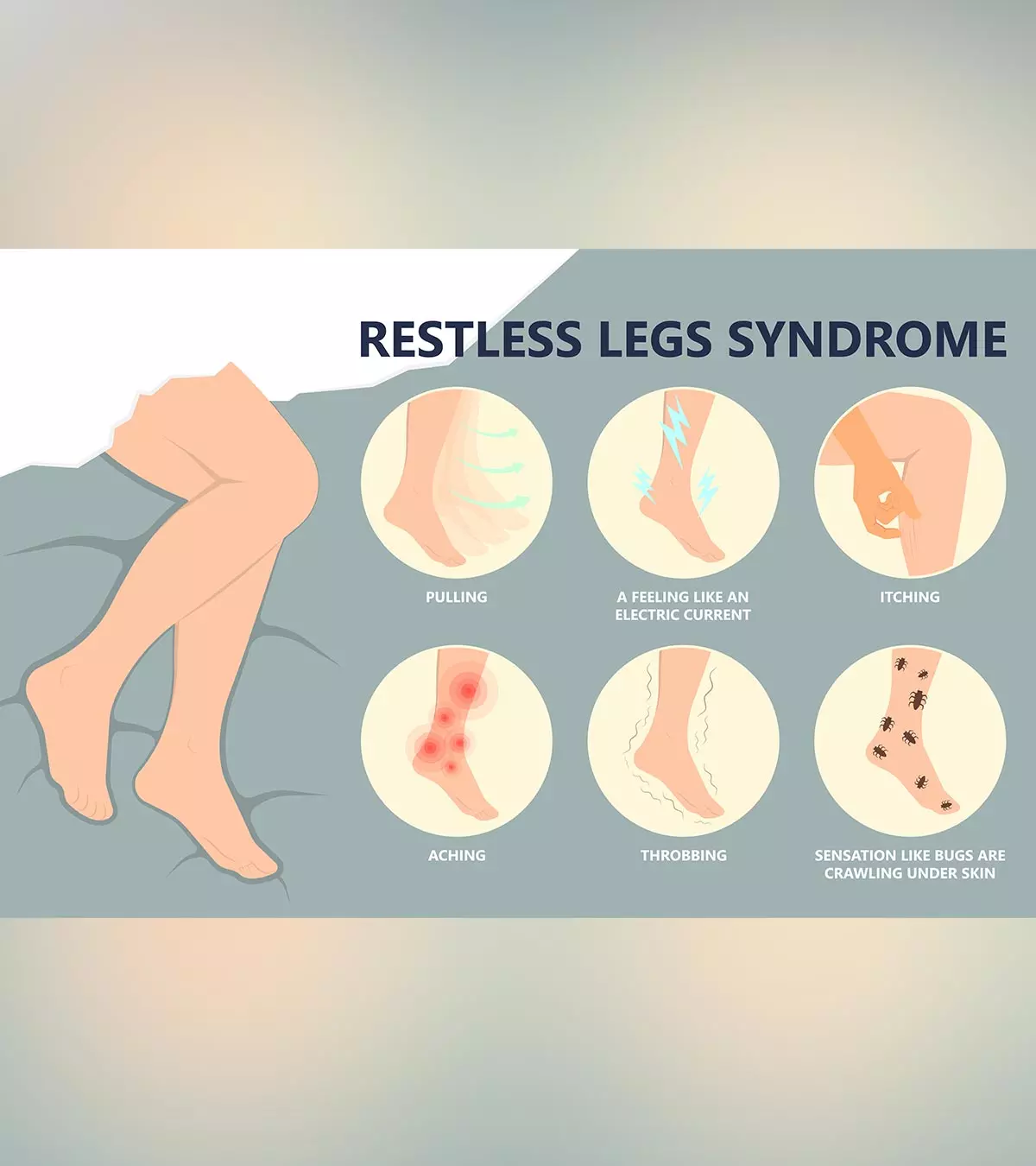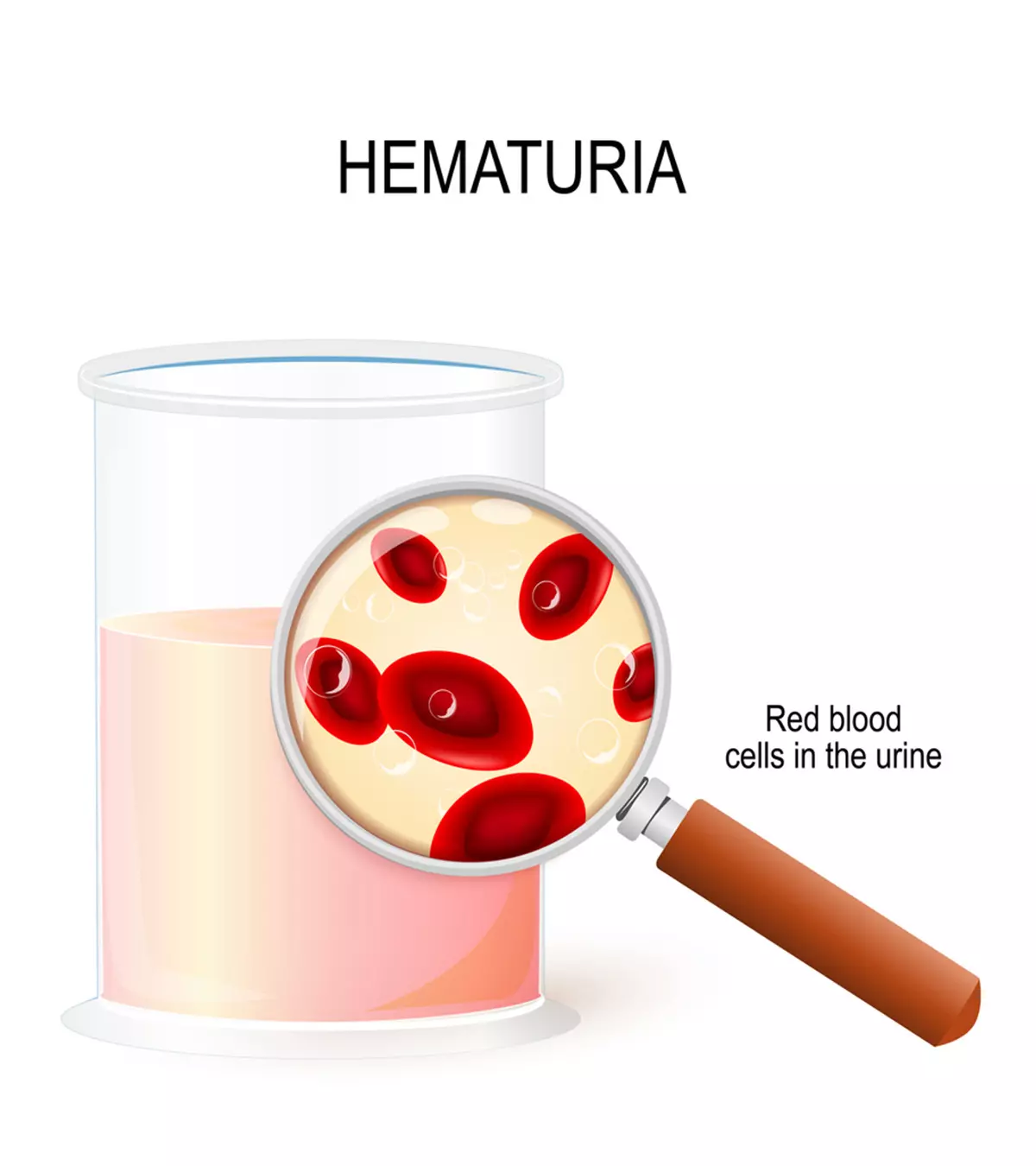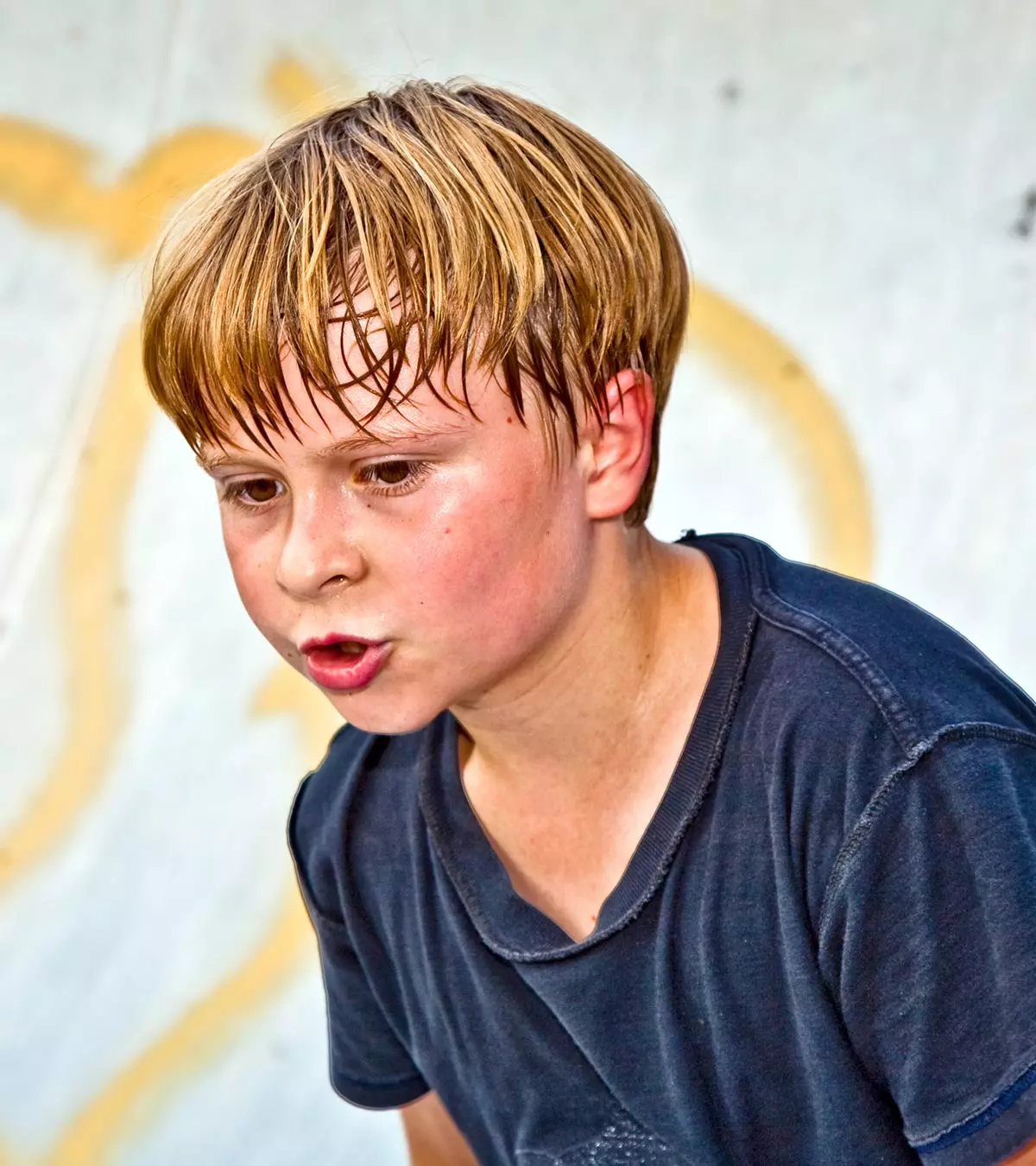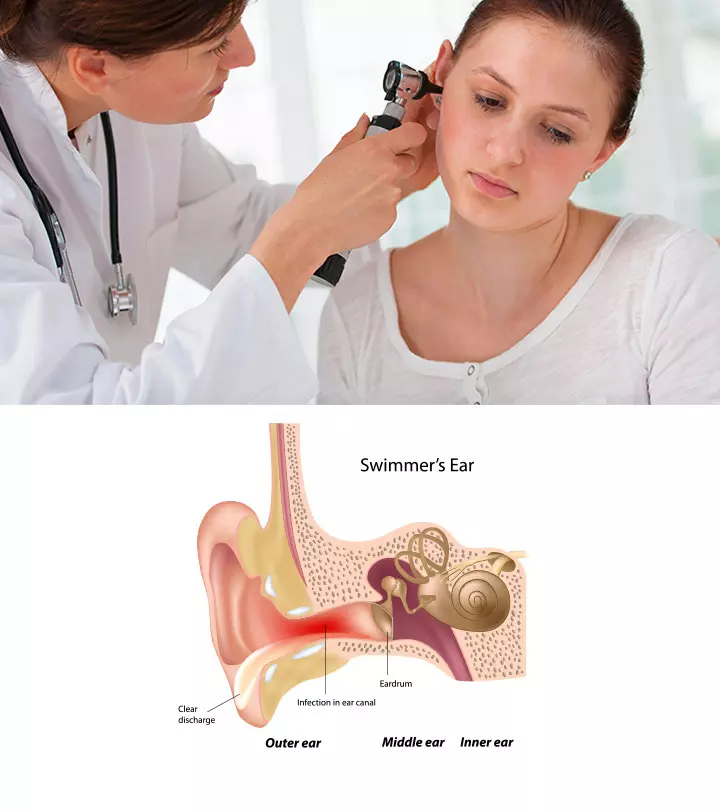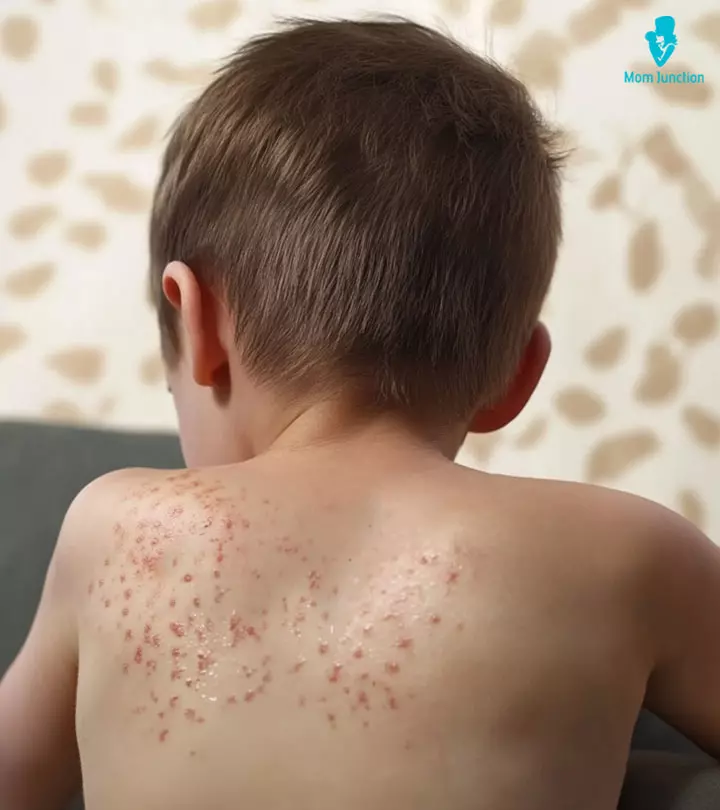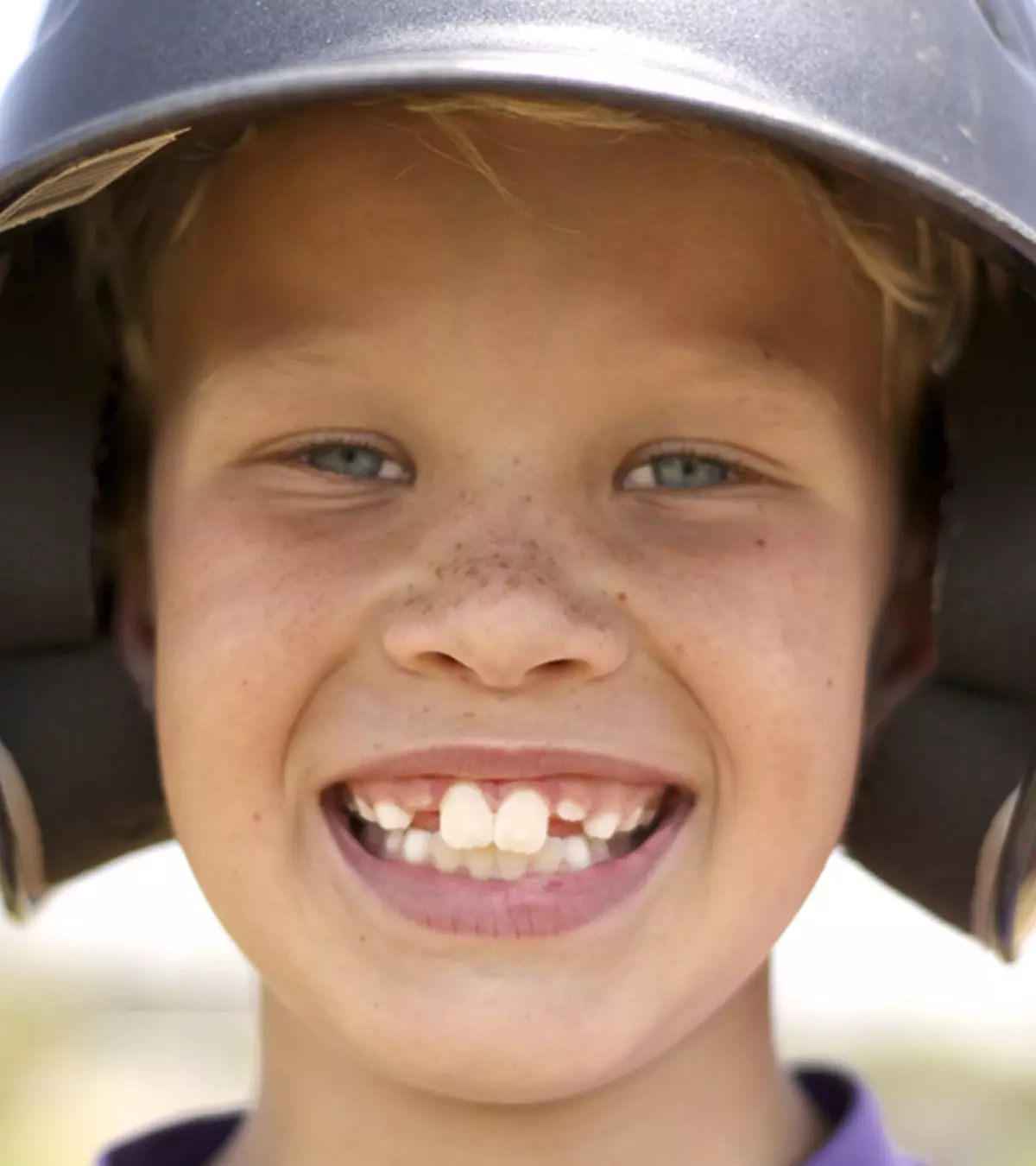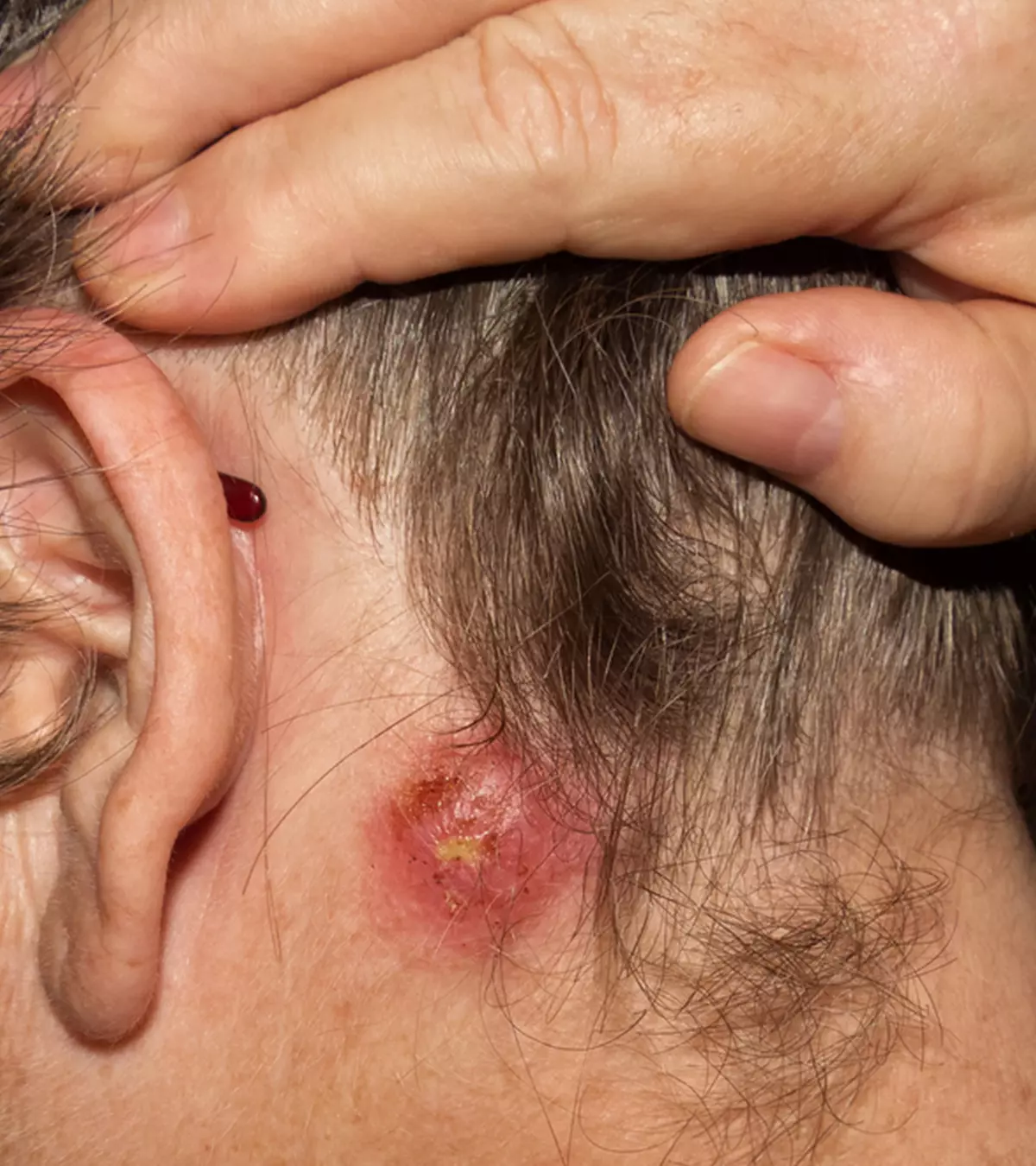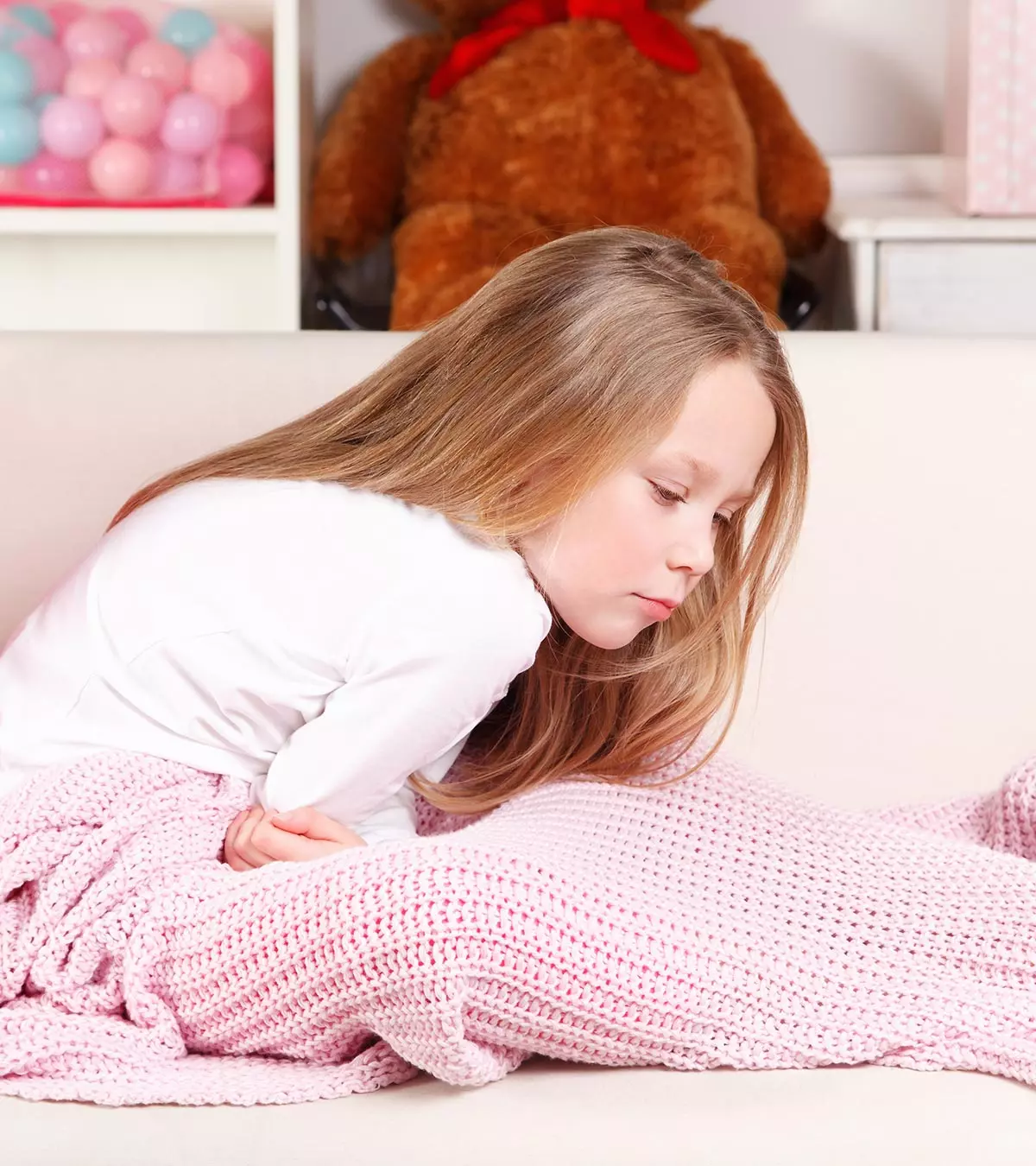
Image: Shutterstock
Pinworms are intestinal worms which are very common in kids. Pinworms in kids are characterized by a constant anal itch and resulting irritation or restlessness. The parasitic infection usually happens due to poor oral hygiene and inadequate cleanliness.

Pinworms in children can be treated with oral and topical medicines. Read this post to learn about the causes, symptoms, home remedies, and prevention of pinworm infection in children.
Key Pointers
- Pinworms infection is a contagious infection that mostly affects children between five and ten years.
- Itching around the anus, especially at night, and sleeplessness are common symptoms.
- Pinworm infection isn’t a cause for concern but should be dealt with promptly to avert symptoms, such as irritable bowel and constipation.
- Maintaining personal hygiene and avoiding scratching the anal region could prevent pinworm infection.
What Is A Pinworm Infection?
Pinworm infection develops in the intestine of young children and is mostly found in kids aged between five and ten years. These parasites are very tiny but can be seen with a naked eye.
They live inside the colon of a human body and multiply when the female worms lay eggs during the night. Therefore, the itchiness is the highest during bedtime.
What Does A Pinworm Look Like?

Pinworms look similar to small pieces of dental floss or white cotton thread. Hence, they are also called threadworms. They are about half an inch in size and look like a jelly type structure.
Is A Pinworm Infection Harmful To Kids?
No, worms in children are not harmful or life-threatening
. An infection caused by pinworms only results in severe itching and sleepless nights. But it is always advisable to take precautions and seek expert advice.
There are various remedies to cure pinworm infection and visiting a health professional would help in recovering faster.
Is Pinworm Infection Contagious?

Yes, an infection caused by pinworms is contagious and spreads quickly among children, especially those who are in daycare facilities. Its transmission could be through a toilet seat, by not maintaining a hygienic environment and through other ways, which we will see next.
Barbara Carter, a mother of three, shares her experience when her daughter contracted a pinworm infection. She says, “My 7- year-old daughter rushed out of the bathroom and said, “Something is moving around in my poop.”… She led me to the washroom. I looked down into the toilet bowl and stood frozen. Her well-formed turds had short, thin white lines moving around on them. Something appeared alive, and it terrified me… The next day, I took my daughter to the doctor. “Pinworms,” the doctor said… He wrote the name of a product to purchase at the pharmacy. Instructed me to wash all bedding in hot water and treat every family member in our household (i).”
How Does Pinworm Infection Spread?
A very significant cause of pinworm infection is the lack of hygiene. Threadworms in children can spread in the following ways:
- Transfer of eggs: When an infected child scratches their anus and touches any object, the eggs can transfer from their hands to the object, and spread to other children when they use the same unclean object.
- Air: Eggs can also be present in the air exhaled by an infected person. Thus, pinworm infection can spread even when the eggs get deposited on a food item, and a child eats it.
Pinworm eggs have a life of about two weeks when they are deposited on clothing, bedsheets or any object.
Therefore, maintaining cleanliness and hygiene is extremely important to keep your children safe.
Symptoms Of A Pinworm Infection
Here are the most common symptoms of worms in children (1):
Normal symptoms:
- Rashes and itching around the anus
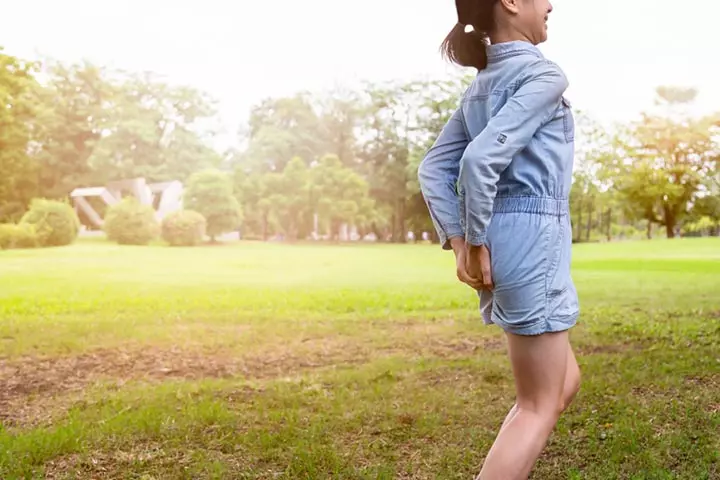
- Irritable bowels
- Sleeplessness
- Constipation
- Bed wetting
Severe symptoms:
- Loss of appetite
- Vaginal discharge in girls of any age
- Extreme weight loss
- Disturbed behavior like irritability
- Difficulty concentrating
- Sleep disturbances
 Point to consider
Point to considerWhen To Seek Medical Advice
It is advisable to take your child to a doctor if you see any of the symptoms of pinworm infection. However, seek immediate medical care if (9):
- You spot pinworms on your child.
- The child is experiencing severe itching in and around the anus, affecting the child’s daily routine.
- The skin around the anus has become tender, inflamed, or red.
How Is A Pinworm Infection Diagnosed?
Tape test is used for the diagnosis of the pinworm infection in children (2). This test can be performed either at home or at a doctor’s clinic. It does not require any preparation and can be done quickly to detect pinworm eggs around the anal area. Tape test is a common name and is also referred to as Oxyuriasis test or Enterobiasis test in medical terminology.
The test can be done on three alternate days to improve the chances of detection, and involves three simple steps:
- Cut an inch of cellophane tape and stick it firmly near the anal opening for a few seconds.
- Gently remove the tape and place it in a ziplock bag. Don’t forget to wash your hands after securing the tape.
- Take this sample to your doctor for examination of the eggs and worms, if any.
How To Treat Pinworm Infection?

If your kid is diagnosed with pinworm infection, then the doctor might prescribe some anthelmintic drugs such as mebendazole or albendazole, and pyrantel pamoate, which is available without a prescription (3). They may also prescribe Terramycin 5mg per pound of your child’s weight (4) .
For the child to recover quickly, give the medicines as directed by the physician and complete the entire course of dosage. Your doctor may advise the whole family to take a precautionary dose of medicines as pinworms are contagious. Most importantly, trim your child’s nails and make them wear a well-fitting undergarment to prevent them from scratching their bottom. Otherwise, they keep getting reinfected from their own fingers (autoinfection).
Note that it is not advisable to use over-the-counter medicines for children. Therefore, consult a doctor for advice.
 Be watchful
Be watchfulHome Remedies To Treat Pinworm Infection
Some of the most popular home remedies for curing a pinworm infection are:
- Apple cider vinegar (ACV): The acidic nature of vinegar aids in fighting infections. Mix two tablespoons of ACV in a glass of water and make the child drink it twice a day. This helps in flushing out the worms from the body (5).
- Garlic: Garlic kills the eggs and worms. It can be added in the food or topically applied at the anal area to fight the bacterial infections. Do not use garlic if your child has even mildly sensitive skin (4).
- Virgin coconut oil: Coconut oil has antifungal and antibacterial properties, which help battle the infection caused by pinworms. Swallowing a teaspoon of pure coconut oil in the morning and applying it topically over the anus before going to bed will benefit the child (6).

There is no scientific research to substantiate the cure of pinworms through home remedies, but the effectiveness is anecdotal. A home remedy which works for one person may or may not work for another. Also, do not use home remedies if your child is allergic to any of the ingredients.
How To Prevent Pinworms In Children?
Pinworm eggs can spread quickly if precautionary steps are not taken. Some of the necessary preventive measures are (3):
- Personal hygiene: Do not share towels, bed sheets or any clothing with an infected person. Make the children wash hands especially before meals and bathe properly. Change their undergarments at least twice a day and wash them immediately.
- Sunlight: Pinworm eggs die when sunlight hits the surface where they are lying. Therefore, open the doors and windows to bring as much sunlight into the room as possible.

- Don’t scratch: Even if the itch is irresistible and out of your control, ask the child not to scratch. Scratching a lot will lead to a rash and complicate the healing process. Moreover, if the child puts an unclean finger in the mouth after scratching, it will lead to reinfection and they might not get better despite treatment. You can also trim the child’s nails to reduce the after-effect of scratching. Also, let them wash their hands immediately after scratching.
- Laundry: Wash the clothes and bedding used by an infected person in hot water to make sure any infestation is completely out.
Next, we answer a few questions that our readers frequently ask.
Frequently Asked Questions
1. Is it possible to get pinworms from my pets?
No. Pinworms or Enterobius vermicularis can live only in human bodies. Therefore, getting an infection from your pets or vice-versa is ruled out.
2. Can pinworm infection occur again?
Yes, pinworm infection spreads easily and may recur if your child is living in unhygienic conditions or does not maintain cleanliness in his/her daily lifestyle.
3. How long can one be contagious with pinworms?
Pinworm eggs may survive on the bedding, couches, and other surfaces for nearly two to three weeks. Hence, the surroundings could be contagious even after a child recovers from the infection. Change the bedding frequently after the infection to prevent contamination. Also, encourage healthy hygiene practices among children to reduce the risk of reinfection (7) (8).
4. Why do pinworms keep coming back after treatment?
The recurrence of a pinworm infection could be because the eggs continue to live on household items. Hence, it is important to clean the house regularly after an infection. Improper personal hygiene may also contribute to pinworm reinfections after the treatment.
Infection from pinworms in kids is common and not a concerning condition. If your child displays irritation, itchiness near the anal area, or sleeplessness, it may be an indication of pinworm infection. So talk to your child’s doctor, and they can recommend required medications and home care. However, maintain proper hygiene to avoid such discomforts. Wear clean clothes and follow the necessary preventive tips to stop this infection from occurring in the first place.
Infographic: Management And Treatment Of Pinworm Infection In Children
Pinworm infection is common in children, causing itching and rashes around the anus, sleeplessness, and other discomforts. However, once diagnosed, it can be effectively treated and managed. The infographic below presents several methods to treat and manage symptoms of this infection in children.
Some thing wrong with infographic shortcode. please verify shortcode syntaxIllustration: Pinworms In Kids: Symptoms Causes Treatment And Prevention

Image: Dall·E/MomJunction Design Team
Check out this informative video to learn about how pinworm infections occur. Gain an in-depth understanding of the causes of this infection and how it can be treated.
Personal Experience: Source
MomJunction articles include first-hand experiences to provide you with better insights through real-life narratives. Here are the sources of personal accounts referenced in this article.
i. Come Look in The Toilet, My Daughter Said; Barbara Carterhttps://medium.com/age-of-empathy/come-look-in-the-toilet-my-daughter-said-586aa865a8b3
References
- Cinthia A. Acka et al.; Parasitic Worms: Knowledge, Attitudes, and Practices in Western Côte d’Ivoire with Implications for Integrated Control; PLoS Neglected Tropical Diseases (2010)
- Pinworm test; National Institutes of Health (NIH)
- Clinical Overview of Pinworm infection; Centers for Disease Control and Prevention (CDC) (2025)
- M.D. Thomas S. Bumbalo et al; The treatment of pinworm infection (Enterobiasis); The Journal of Pediatrics
- Carol S. Johnston and Cindy A. Gaas; Vinegar: Medicinal Uses and Antiglycemic Effect; MedGenMed (2006)
- Swee Keong Yeap et al; Antistress and antioxidant effects of virgin coconut oil in vivo; Experimental and Therapeutic Medicine (2015)
- About Pinworm Infection; Centers for Disease Control and Prevention (CDC) (2025)
- Preventing Pinworm Infection; Centers for Disease Control and Prevention (CDC) (2025)
- Pinworm Infections; Nemours Kids Health
- Pinworms; Seattle Children’s Hospital
Community Experiences
Join the conversation and become a part of our nurturing community! Share your stories, experiences, and insights to connect with fellow parents.
Read full bio of Dr. Anuradha Bansal
Read full bio of Shivali Karande
Read full bio of Swati Patwal
Read full bio of Dr. Joyani Das





